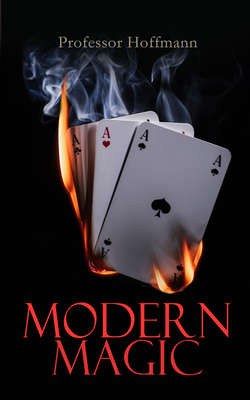Читать книгу Modern Magic - Professor Hoffmann - Страница 7
На сайте Литреса книга снята с продажи.
THE MAGICIAN’S DRESS.
ОглавлениеTable of Contents
It is not very many years since the orthodox dress of the conjuror was a long and flowing robe, embroidered more or less with hieroglyphic characters, and giving ample space for the concealment of any reasonable sized article—say from a warming-pan downwards. The very last specimen of such a garment, to the best of our belief, is, or was, worn by the magician attached to the Crystal Palace. We do not know whether he is compelled by the regulations of the establishment to wear such a robe; but if so, it ought to be liberally considered in his salary. The costume de rigueur of the magician of the present day is ordinary “evening dress.” The effect of the feats performed is greatly heightened by the close fit and comparative scantiness of such a costume, which appears to allow no space for secret pockets or other place of concealment. In reality, however, the magician is provided with two special pockets, known as profondes, placed in the tails of his dress-coat. Each is from four to six inches in depth and seven in width, and the opening, which is across the inside of the coat-tail, slanting slightly downwards from the centre to the side, is, like the servante, so placed as to be just level with the knuckles of the performer, as his hand hangs by his side. He can thus, by the mere action of dropping either hand to his side, let fall any article instantly into the profonde on that side, or take anything from thence in like manner. The action is so natural, that it may be used under the very eyes of the audience, at very small risk of their observing it; and if the performer at the same moment slightly turns his other side to the spectators, he may be perfectly secure from detection. Some performers have also a couple of pochettes (small pockets) made in the trousers, one behind each thigh. These are generally used for purposes of production only, the profondes being still employed for getting rid of any article, which, indeed, is their primary purpose, for they were originally made too deep (‘profonde,’ whence their name) to get articles easily out of them. Many professors, in addition to the pockets above mentioned, have also a spacious pocket, opening perpendicularly, inside the breast of the coat, under each arm, for the purpose of what is called “loading,” i.e., bringing a rabbit, or other article, into a hat, etc. Other pockets may be added, as the fancy or invention of the performer may dictate; but the above are those generally used.
It will also be found a great convenience to have an elastic band, about an inch in width, stitched around the lower edge of the waistcoat on the inside. When the waistcoat is in wear, the band makes it press tightly round the waist, and any object of moderate size—a card, or pack of cards, a handkerchief, etc.—may be slipped under it without the least risk of falling. Used in conjunction with the pockets before described, this elastic waistband affords a means of instantaneously effecting “changes” of articles too large to be palmed with safety; one hand dropping the genuine article into the profonde on that side, while the other draws the prepared substitute from under the waistband, a very slight turn of the body, towards the table or otherwise, sufficing to cover the movement.
With these few preliminary observations, we proceed to the practice of the art, commencing with the ever-popular class of illusions performed by the aid of playing cards.
